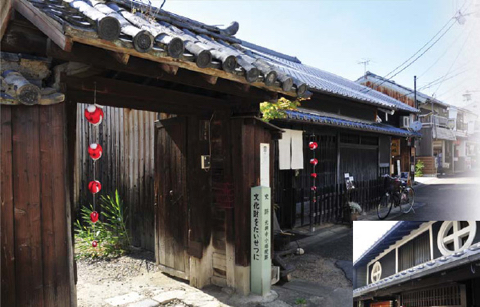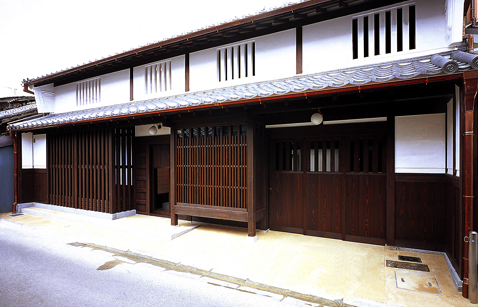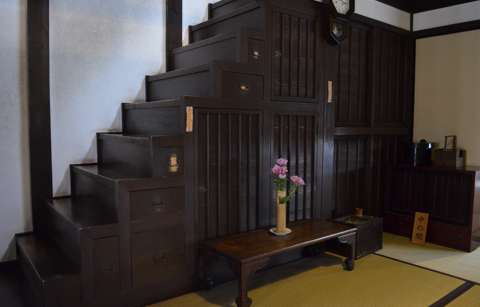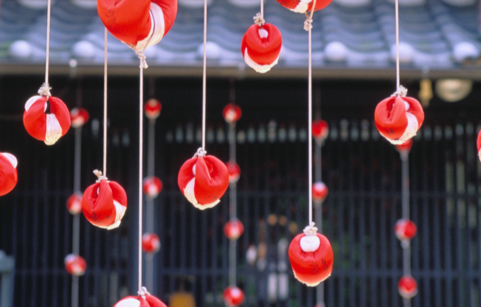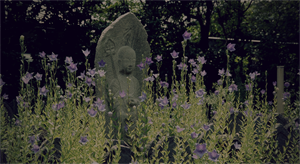House with Latticework in Naramachi
Traditional merchant house in Naramachi is reproduced here. You can visit the house to directly learn the lifestyle of old merchants in Nara or how merchants lived at that time. You can also use the house as a place of relief.
- 44 Gangoji-cho, Nara City
- Tel: 0742-23-4820
- Opening hours: 9:00 a.m. - 5:00 p.m.
- Closing days: Monday (following Tuesday when Monday is a national holiday), year-end and New Year holidays
Naramachi Monogatari-kan (Story Telling House)
Traditional merchant house was renovated for this facility. In this house, people involved in town planning gather for interaction, transmitting a variety of information on town planning.
- 2-1 Nakanoshinya-cho, Nara City
- Tel: 0742-26-3476
- Opening hours: 10:00 a.m. - 5:00 p.m.
- Closing days: Bon and New Year holidays
Koshindo
Small shrine for Koshin belief in Naramachi. A charm of “Scapegoat Monkey” as a messenger of Blue-Faced Vajra is hanging from the eaves of the house to expel evil spirits.
- 39 Nishinoshinya-cho, Nara City
Imanishi-ke Shoin
This is a shoin-style house, following the traditional form of the Muromachi period. This house is also a precious structure in the history of architecture in Japan. You can enjoy a bowl of powdered tea, looking at a well-maintained Japanese garden.
- 24-3 Fukuchiin, Nara City
- Tel: 0742-23-2256
- Opening hours: 10:00 a.m. - 4:00 p.m.
- Closed days: Monday (following Tuesday when Monday is a national holiday), year-end and New Year holidays
Naramachi Museum
A variety of old, nostalgic folkcraft articles, statues of Buddha, signboards, old coins, and other art works are exhibited.
- 14 Nishinoshinya-cho, Nara City
- Tel: 0742-22-5509
- Admission fees/Free
- Open 365 days a year
Sarusawa Pond
This artificial pond was made in 749 to release caught fish there as a religious ceremony called “Hojo-e” conducted by Kohfukuji Temple. The five-story pagoda surrounded by willows reflected on the surface of the pond is very beautiful, and that scenery is one of the representative views in Nara.
Former Residence of Naoya Shiga
The former residence of Naoya Shiga, a great writer of the Shirakaba school. Living for nine years from 1929, he completed his novel “Anya Koro (A Dark Night's Passing)” here. This house was also called the “Takabatake Salon,” where cultural celebrities and artists interacted with one another.
- 1237-2 Takabatakedaido-cho, Nara City
- Tel: 0742-26-6490
- Opening hours: 9:30 a.m. - 5:30 p.m. (March through November), 9:30 a.m. - 4:30 p.m. (December through February)
- Closed days: Monday, (any day when chartered), year-end and New Year holidays
- Admission fees: ¥350 for adults (¥200 for junior high school students, ¥100 for elementary school students)
Zutou Tower
An earthen tower like a seven-step pyramid 30 m in side and 10 m in height is said to have been built by Buddhist monk named Jicchu of Todaiji Temple in the Nara period. It is also said to be a burial mound for the head of a Buddhist monk named Gembo.
- 921 Takabatake-cho, Nara City
- Tel: 0742-26-3171
- Opening hours: 9:00 a.m. - 5:00 p.m.
- Admission fee: ¥300 (Contact: Wellness Asukaji) 0742-22-2857
Ukimido Floating Gazebo
This gazebo with cypress bark roof built in Hakkakudo-style (hexagonal shape) floats on Sagi Pond. It beautifully reflects on the surface of the pond. The gazebo is used as a place of relief by visitors, who can also enjoy cherry blossoms in spring and beautiful colored leaves in autumn.
- 奈良市西新屋町14
- TEL.0742-22-5509
- 開館時間/10:00~16:00
- 見学料/無料
- 休み/無
Nara Hotel
This is a long-established hotel founded in 1909 on the site of Daijoin. The building constructed all in Japanese cypress, top grade timber, was gorgeous. Its relaxing interior will also console the heart of a traveler.
- 1096 Takabatake-cho, Nara City
- Tel: 0742-26-3300
